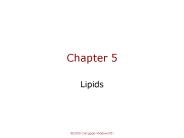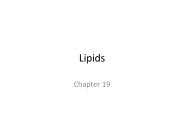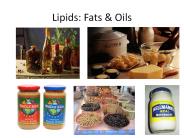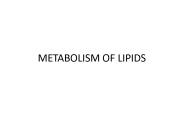Lipids PowerPoint PPT Presentations
All Time
Recommended
1-56 of over 5,000
Lipids Lipids Main functions of lipids in foods Energy and maintain human health Influence on food flavor Fatty acids impart flavor Lipids carry flavors/nutrients ...
| PowerPoint PPT presentation | free to view
Lipids Readings: Chapter 5 *
| PowerPoint PPT presentation | free to download
LIPIDS Characteristics of Lipids Composed of Carbon, ... Energy storage molecules Phospholipids part of cell membrane Fatty Acid Structure Carboxyl group ...
| PowerPoint PPT presentation | free to view
Lipids Triglycerides Phospholipids Sterols Lipids Lipids are a class of nutrients that includes: Triglycerides (fats and oils) Phospholipids Sterols Waxes Composed of ...
| PowerPoint PPT presentation | free to view
Title: LIPIDS Author: Unknown User Last modified by: Humes, William Created Date: 9/30/2003 12:30:44 AM Document presentation format: On-screen Show (4:3)
| PowerPoint PPT presentation | free to view
Arial Calibri Office Theme Lipids PowerPoint Presentation General Uses of Lipids Types A. FATS AND OILS General Structure of Triglycerol PowerPoint ...
| PowerPoint PPT presentation | free to view
LIPIDS Characteristics of ... 123Angles1 Arial Calibri Times New Roman Elephant Rockwell Blank Presentation Bitmap Image PowerPoint Presentation Characteristics of ...
| PowerPoint PPT presentation | free to view
LIPIDS LIPIDS Definition: Lipids are organic molecules with long hydrocarbon chains that are soluble in non-polar solvents. They have different uses: Energy storage.
| PowerPoint PPT presentation | free to download
Lack of a functional enzyme at any point leads to accumulation of the sphingolipid product in the nerve s Schwan cells or deposits in these cells that cause those ...
| PowerPoint PPT presentation | free to view
Lipids L. Scheffler IB Chemistry 1-2 Lincoln High School * Lipids Lipids are organic molecules with long hydrocarbon chains that are soluble in non-polar organic ...
| PowerPoint PPT presentation | free to view
Lipids A family of chemical compounds that are a main component in every living cell. Trigylcerides Fuel Warmth Stored in Adipose Tissues Cushions Organs Oils ...
| PowerPoint PPT presentation | free to view
LIPIDS Lipids are hydrophobic molecules composed of C, O, and H. In general, they contain fewer O-H bonds and more C-H bonds than carbohydrates do.
| PowerPoint PPT presentation | free to view
Good things about 'fat' Bad things about 'fat' Lipid Chemistry (ugh) ... Maintain cell walls and play role in making Vitamin D. Nutritional Overview. Food Sources ...
| PowerPoint PPT presentation | free to view
Title: LIPIDS Author: Floyd College Last modified by: ghc Created Date: 2/5/2004 9:09:25 PM Document presentation format: On-screen Show (4:3) Company
| PowerPoint PPT presentation | free to view
Lipids Lipids (Fats) Lipids are a group of substances that are relatively insoluble in water Some of these substances include: Triglyceride = 95% of all Fats (body ...
| PowerPoint PPT presentation | free to download
Title: Welcome Author: harini Last modified by: Harini Document presentation format: Custom Other titles: Arial Lucida Sans Unicode Wingdings Symbol Times New Roman ...
| PowerPoint PPT presentation | free to view
gives some clue as to the average size of fatty acids in a given sample of fat ... the iodine number is the number of grams of iodine absorbed by 100 grams of fat ...
| PowerPoint PPT presentation | free to view
Lipids. Definition. Lipids are ... www.biology.lsu.edu/.../ OrganicMolecules.html. Hydrocarbons. Example: Butyric acid. www.krysstal.com/ organic.html ...
| PowerPoint PPT presentation | free to view
Lipids: a heterogeneous class of naturally occurring organic compounds ... (e.g., cholic acid) progesterone C-21. 26-35. Bile Acids ...
| PowerPoint PPT presentation | free to view
... immediately outside plasma ... of Lipoproteins High-density ... of ApoA to ApoB used to assess CVD risk Indiviuals respond differently to ...
| PowerPoint PPT presentation | free to download
Lipids Large non-polar organic molecules that do not dissolve in water. Lipids Overview They are large organic molecules They contain carbon, hydrogen, and oxygen ...
| PowerPoint PPT presentation | free to view
Lipids. Lipids are non-polar (hydrophobic) compounds, soluble ... 18:1 cisD9 oleic acid ( 9) 18:2 cisD9,12 linoleic acid ( 6) 18:3 cisD9,12,15 a-linolenic acid ...
| PowerPoint PPT presentation | free to view
Properties of Triglycerides ... e.g., butyric acid, which have bad taste and odor. Properties of Triglycerides. NaOH. Saponification. Mixture of fatty acid ...
| PowerPoint PPT presentation | free to download
Good vs. Bad Cholesterol. Related to lipoproteins (protein lipid complexes) ... LDL cholesterol of less than 100 mg/dL is the optimal level. ...
| PowerPoint PPT presentation | free to view
Lipid - bioorganic substance found in living organisms that is insoluble (or ... Typically an even number of carbons. Are either long (C12-C26), medium (C8-C10) ...
| PowerPoint PPT presentation | free to view
Stryer Fig. 12.12 A Liposome. Stryer Fig. 12.13 Preparing a gly filled liposome. Stryer Fig. 12.15 Permeability coefficients in a lipid bilayer ...
| PowerPoint PPT presentation | free to view
extensive regions of hydrocarbon with only small proportion of polar groups ... 18 oleic CH3(CH2)7CH=CH(CH2)7COOH. 18 linoleic CH3(CH2)4CH=CHCH2CH=CH(CH2)7COOH ...
| PowerPoint PPT presentation | free to view
Chapter 8 Lipids Biochemistry by Reginald Garrett and Charles Grisham Essential Question What is the structure, chemistry, and biological function of lipids?
| PowerPoint PPT presentation | free to view
cholesterol is found in the diet - principally in meat, cheese and ... levels of HDL/LDL are thought to be controllable with diet and exercise. Tests for Lipids ...
| PowerPoint PPT presentation | free to view
Often solid at room temperature. Contain only single C-C bonds ... Vegetable oils, chicken, fish, vegetables, avocados. Hydrogenation ...
| PowerPoint PPT presentation | free to view
Lipids. The Good, the Bad and the Truly Ugly! Insoluble in water. ( hydrophobic) ... Good! The Bad! The Truly Awful! The Ugly. The Consequences of Poor Choices! ...
| PowerPoint PPT presentation | free to view
Lipid- water insoluble organic substance extractable by nonpolar ... Lipid Solubility. Amphipathic- hydrophilic and hydrophobic regions. Possible arrangements ...
| PowerPoint PPT presentation | free to view
Lipids Chapter 19 Structure and classification of lipids Lipids are organic compounds that are found in living organisms that are soluble in non-polar organic solvents.
| PowerPoint PPT presentation | free to download
Lipid- water insoluble organic substance extractable by nonpolar solvents, ... Singer's Fluid Mosaic Model. peripheral and integral membrane proteins ...
| PowerPoint PPT presentation | free to view
Lipids Phospholipids Steroids and Cholesterol Plasma (Cell)Membranes Phosphoglycerides Most abundant lipids in cell membranes Control cell permeability FATTY ACID ...
| PowerPoint PPT presentation | free to download
Ester bond between alcohol and fatty acid. Glycerides ... Soap. Micelles. Lipid Bilayer. polar heads. hydrophilic. nonpolar tails. hydrophobic. polar heads ...
| PowerPoint PPT presentation | free to view
Lipids are composed of C, H, O. long hydrocarbon chain. Diverse ... liposome. early evolutionary stage of cell? 2005-2006. AP Biology. Why is this important? ...
| PowerPoint PPT presentation | free to view
... wax, which is obtained from the carnauba palm and is used in car and floor waxes ... liver damage, decreases sperm production, sleep disturbances, acne, etc. ...
| PowerPoint PPT presentation | free to view
The ratio of oxygen to carbon is extremely small (O/C 1) ... Lipids are soluble in non-polar solvents such as chloroform or ether ...
| PowerPoint PPT presentation | free to view
Lipids: Fats & Oils Lipids Lipids Lipids are composed of C, H, O long hydrocarbon chain Diverse group fats phospholipids steroids Do not form polymers big molecules ...
| PowerPoint PPT presentation | free to view
Complex Lipids Globosides Ceramide oligosaccharides Addition of monosaccharides (including GalNAc) to a glucocerebroside e.g. Cer-Glc-Gal (lactosylceramide ...
| PowerPoint PPT presentation | free to view
Lipids: Fats & Oils Lipids Lipids Examples fats oils waxes hormones sex hormones testosterone (male) estrogen (female) Lipids Function: energy storage very ...
| PowerPoint PPT presentation | free to download
Lipids: Fats & Oils ... fats phospholipids steroids Do not form polymers big molecules made of smaller subunits not a continuing chain Fats Structure: glycerol ...
| PowerPoint PPT presentation | free to download
Lipids: Fats & Oils * Mostly plant lipids Think about natural peanut butter: Lots of unsaturated fats Oil separates out Companies want to make their product ...
| PowerPoint PPT presentation | free to download
LIPIDS 101 Ulrich K. Schubart ... LDL HDL 86 55 6 5 5 7 50 19 6 18 22 22 40 33 22 2 Major apolipoproteins and their functions Apolipoprotein Structural Ligand ...
| PowerPoint PPT presentation | free to download
Definition, classification, structure and properties of lipids
| PowerPoint PPT presentation | free to download
Complex Lipids Globosides Ceramide oligosaccharides Addition of monosaccharides (including GalNAc) to a glucocerebroside e.g. Cer-Glc-Gal (lactosylceramide ...
| PowerPoint PPT presentation | free to view
Metabolism of lipids Course Content Digestion and absorption of lipids Triacylglycerol metabolism Phospholipid metabolism Cholesterol metabolism plasma lipoprotein ...
| PowerPoint PPT presentation | free to view
Chapter 5 lipids metabolism LIPIDS Water-insoluble substances that can be extracted from cells by nonpolar organic solvents Characteristics of fat Hydrophobic because ...
| PowerPoint PPT presentation | free to view
Lipids CHEM 2124 ... lipids Classify fatty acids and describe the relationship between melting point and the number of double bonds Draw the structure of ...
| PowerPoint PPT presentation | free to view
Fats and Lipids Lipids Lipids are varied in structure. Many are insoluble in water because they lack polar groups. Types of Lipids and their Functions 1.
| PowerPoint PPT presentation | free to download
Lipids are not made of monomers ... a lipid bilayer surrounds EVERY LIVING CELL PowerPoint Presentation Cell membranes are made of phospholipids A Cell Membrane ...
| PowerPoint PPT presentation | free to download
Title: Transport of lipids Author: Franklin R. Leach Last modified by: Franklin Leach Created Date: 3/4/1999 7:37:13 PM Document presentation format
| PowerPoint PPT presentation | free to view
METABOLISM OF LIPIDS ... bond between fatty acid and other molecules can be hydrolysed using lipases enzyme Phosphoacylglycerols membrane component ...
| PowerPoint PPT presentation | free to download
























































